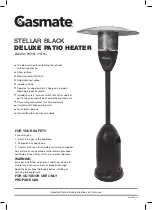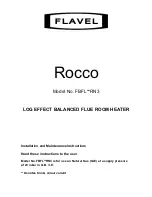
Rinnai Tankless Water Heater Installation and Operation Manual
19
4.3 Choose an
Installation
Location
When selecting an installation location, you
must ensure that clearances will be met and
that the vent length will be within required
limits. Consider the installation environment,
water quality, and need for freeze protection.
Requirements for the gas line, water lines,
electrical connection, and condensate disposal
can be found in their respective installation
sections in this manual.
4.3.1 Water Quality
Guidelines
This section provides information on the
importance of water quality to the Rinnai
Tankless Water Heater. The information is
intended to serve as general guidelines only and
is not a complete list of water quality guidelines.
Consideration of care for your water heater
should include evaluation of water quality.
The water must be potable, free of corrosive
chemicals, sand, dirt, or other contaminants. It
is up to the trained and qualified professional
to ensure the water does not contain corrosive
chemicals or elements that can affect or damage
the Rinnai Tankless Water Heater. Water that
contains chemicals exceeding the levels below
can damage the Rinnai Tankless Water Heater.
Replacement of components due to water quality
damage is not covered by the warranty.
If you install this water heater in an area that
is known to have hard water or that causes
scale build-up, the water must be treated and
may require a more frequent flushing schedule.
This water heater includes a service indicator
(Service Soon,
SS
). When selected in the
parameter settings, an
SS
code will display on
the controller indicating that it is time to flush
and service the water heater. Scale build-up is
caused by hard water and can be accelerated
if the water heater is set at a high temperature.
Rinnai offers Southeastern Filtration’s
“ScaleCutter Water Conditioning System”
that offers superior lime scale prevention and
corrosion control.
4.3.2 Environment
Air surrounding the water heater, venting, and
vent termination(s) is used for combustion and
must be free of any compounds that cause
corrosion of internal components.
These include corrosive compounds that are
found in aerosol sprays, detergents, bleaches,
cleaning solvents, oil-based paints/varnishes,
and refrigerants. The air in beauty shops, dry
cleaning stores, photo processing labs, and
storage areas for pool supplies often contains
these compounds. Therefore, it is recommended
that external (outdoor) models be used for
these locations where possible. In applications
utilizing room air where there are high levels of
particulates, Rinnai offers a room air screen.
The water heater, venting, and vent
termination(s) should not be installed in any
areas where the air may contain these corrosive
compounds.
*Source: Part 143 National Secondary Drinking Water
Regulation
Contaminant
Maximum Level
Total Hardness
Up to 200 mg/L
Aluminum *
Up to 0.2 mg/L
Chlorides *
Up to 250 mg/L
Copper *
Up to 1.0 mg/L
Dissolved Carbon
Dioxide (CO2)
Up to 15.0 mg/L
Iron *
Up to 0.3 mg/L
Manganese *
Up to 0.05 mg/L
pH *
6.5 to 8.5
TDS (Total Dissolved
Solids) *
Up to 500 mg/L
Zinc *
Up to 5 mg/L
Table 5: Water Quality Guidelines
















































